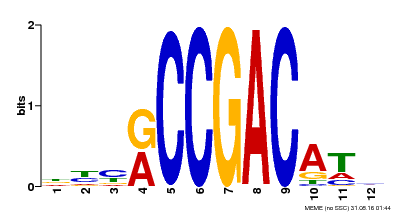- Keily J, et al.
Model selection reveals control of cold signalling by evening-phased components of the plant circadian clock.
Plant J., 2013. 76(2): p. 247-57
[PMID:23909712] - Shi H, et al.
The Cysteine2/Histidine2-Type Transcription Factor ZINC FINGER OF ARABIDOPSIS THALIANA6 Modulates Biotic and Abiotic Stress Responses by Activating Salicylic Acid-Related Genes and C-REPEAT-BINDING FACTOR Genes in Arabidopsis.
Plant Physiol., 2014. 165(3): p. 1367-1379
[PMID:24834923] - Xu F, et al.
Increased drought tolerance through the suppression of ESKMO1 gene and overexpression of CBF-related genes in Arabidopsis.
PLoS ONE, 2014. 9(9): p. e106509
[PMID:25184213] - Bello B, et al.
Cloning of Gossypium hirsutum sucrose non-fermenting 1-related protein kinase 2 gene (GhSnRK2) and its overexpression in transgenic Arabidopsis escalates drought and low temperature tolerance.
PLoS ONE, 2014. 9(11): p. e112269
[PMID:25393623] - Miyazaki Y,Abe H,Takase T,Kobayashi M,Kiyosue T
Overexpression of LOV KELCH protein 2 confers dehydration tolerance and is associated with enhanced expression of dehydration-inducible genes in Arabidopsis thaliana.
Plant Cell Rep., 2015. 34(5): p. 843-52
[PMID:25627253] - Jiang W,Wu J,Zhang Y,Yin L,Lu J
Isolation of a WRKY30 gene from Muscadinia rotundifolia (Michx) and validation of its function under biotic and abiotic stresses.
Protoplasma, 2015. 252(5): p. 1361-74
[PMID:25643917] - Park S, et al.
Regulation of the Arabidopsis CBF regulon by a complex low-temperature regulatory network.
Plant J., 2015. 82(2): p. 193-207
[PMID:25736223] - Catalá R,Salinas J
The Arabidopsis ethylene overproducer mutant eto1-3 displays enhanced freezing tolerance.
Plant Signal Behav, 2015. 10(3): p. e989768
[PMID:25850018] - Shi H,Qian Y,Tan DX,Reiter RJ,He C
Melatonin induces the transcripts of CBF/DREB1s and their involvement in both abiotic and biotic stresses in Arabidopsis.
J. Pineal Res., 2015. 59(3): p. 334-42
[PMID:26182834] - Wang CL,Zhang SC,Qi SD,Zheng CC,Wu CA
Delayed germination of Arabidopsis seeds under chilling stress by overexpressing an abiotic stress inducible GhTPS11.
Gene, 2016. 575(2 Pt 1): p. 206-12
[PMID:26325072] - Gehan MA, et al.
Natural variation in the C-repeat binding factor cold response pathway correlates with local adaptation of Arabidopsis ecotypes.
Plant J., 2015. 84(4): p. 682-93
[PMID:26369909] - Su F, et al.
Burkholderia phytofirmans PsJN reduces impact of freezing temperatures on photosynthesis in Arabidopsis thaliana.
Front Plant Sci, 2015. 6: p. 810
[PMID:26483823] - Gao S, et al.
A cotton miRNA is involved in regulation of plant response to salt stress.
Sci Rep, 2016. 6: p. 19736
[PMID:26813144] - Shi H,Wei Y,He C
Melatonin-induced CBF/DREB1s are essential for diurnal change of disease resistance and CCA1 expression in Arabidopsis.
Plant Physiol. Biochem., 2016. 100: p. 150-155
[PMID:26828406] - Wei T, et al.
Arabidopsis DREB1B in transgenic Salvia miltiorrhiza increased tolerance to drought stress without stunting growth.
Plant Physiol. Biochem., 2016. 104: p. 17-28
[PMID:27002402] - Norén L, et al.
Circadian and Plastid Signaling Pathways Are Integrated to Ensure Correct Expression of the CBF and COR Genes during Photoperiodic Growth.
Plant Physiol., 2016. 171(2): p. 1392-406
[PMID:27208227] - Zhao C, et al.
Mutational Evidence for the Critical Role of CBF Transcription Factors in Cold Acclimation in Arabidopsis.
Plant Physiol., 2016. 171(4): p. 2744-59
[PMID:27252305] - Jia Y, et al.
The cbfs triple mutants reveal the essential functions of CBFs in cold acclimation and allow the definition of CBF regulons in Arabidopsis.
New Phytol., 2016. 212(2): p. 345-53
[PMID:27353960] - Zhao C,Zhu JK
The broad roles of CBF genes: From development to abiotic stress.
Plant Signal Behav, 2016. 11(8): p. e1215794
[PMID:27472659] - Li P, et al.
The Arabidopsis UDP-glycosyltransferases UGT79B2 and UGT79B3, contribute to cold, salt and drought stress tolerance via modulating anthocyanin accumulation.
Plant J., 2017. 89(1): p. 85-103
[PMID:27599367] - Bolt S,Zuther E,Zintl S,Hincha DK,Schmülling T
ERF105 is a transcription factor gene of Arabidopsis thaliana required for freezing tolerance and cold acclimation.
Plant Cell Environ., 2017. 40(1): p. 108-120
[PMID:27723941] - Shi Y, et al.
The precise regulation of different COR genes by individual CBF transcription factors in Arabidopsis thaliana.
J Integr Plant Biol, 2017. 59(2): p. 118-133
[PMID:28009483] - Zhou M,Chen H,Wei D,Ma H,Lin J
Arabidopsis CBF3 and DELLAs positively regulate each other in response to low temperature.
Sci Rep, 2017. 7: p. 39819
[PMID:28051152] - Li H, et al.
BZR1 Positively Regulates Freezing Tolerance via CBF-Dependent and CBF-Independent Pathways in Arabidopsis.
Mol Plant, 2017. 10(4): p. 545-559
[PMID:28089951] - Liu Z, et al.
Plasma Membrane CRPK1-Mediated Phosphorylation of 14-3-3 Proteins Induces Their Nuclear Import to Fine-Tune CBF Signaling during Cold Response.
Mol. Cell, 2017. 66(1): p. 117-128.e5
[PMID:28344081] - Kidokoro S, et al.
Different Cold-Signaling Pathways Function in the Responses to Rapid and Gradual Decreases in Temperature.
Plant Cell, 2017. 29(4): p. 760-774
[PMID:28351986] - Yang L, et al.
Systematic analysis of the G-box Factor 14-3-3 gene family and functional characterization of GF14a in Brachypodium distachyon.
Plant Physiol. Biochem., 2017. 117: p. 1-11
[PMID:28575641] - Carlow CE, et al.
Nuclear localization and transactivation by Vitis CBF transcription factors are regulated by combinations of conserved amino acid domains.
Plant Physiol. Biochem., 2017. 118: p. 306-319
[PMID:28675818] - Cho S, et al.
Accession-Dependent CBF Gene Deletion by CRISPR/Cas System in Arabidopsis.
Front Plant Sci, 2017. 8: p. 1910
[PMID:29163623] - Beine-Golovchuk O, et al.
Plant Temperature Acclimation and Growth Rely on Cytosolic Ribosome Biogenesis Factor Homologs.
Plant Physiol., 2018. 176(3): p. 2251-2276
[PMID:29382692] - Meng LS,Xu MK,Wan W,Wang JY
Integration of Environmental and Developmental (or Metabolic) Control of Seed Mass by Sugar and Ethylene Metabolisms in Arabidopsis.
J. Agric. Food Chem., 2018. 66(13): p. 3477-3488
[PMID:29528636]
|





